
When most people think of Russia, images of Vladimir Putin, St. Basil’s Cathedral and copious caviar probably come to mind. But there’s a lot more to this potential superpower than that. All across its 6 million square miles, you can discover strange sights, customs, delicacies and more — all unique to Russia itself. From swimming with sex dolls to visiting an enema museum, take a trip around this curious former communist country from the comfort of your own home.
Enema of the State
Sorry to start this off on a low note, but let’s talk about enemas. Apparently Russians don’t shy away from this medical aid, because in June 2008 a monument in honor of the enema was unveiled at a health spa in the southern city of Zheleznovodsk.

The 70-pound bronze monument designed by local artist Svetlana Avakova is held proudly aloft by three Botticelli-style angel figurines. And in an arguably rare insight into Russian humor, it’s complemented by a banner on one of the spa’s walls reading, “Let’s beat constipation and sloppiness with enemas.”
Good, Clean Culture
Continuing with the health theme for a moment, how about a visit to a museum dedicated to hygiene? Taking pride of place in a former palace in St. Petersburg, the Muzei Gigieny, or Museum of Hygiene, opened way back in 1919 to educate residents on health and personal hygiene issues.
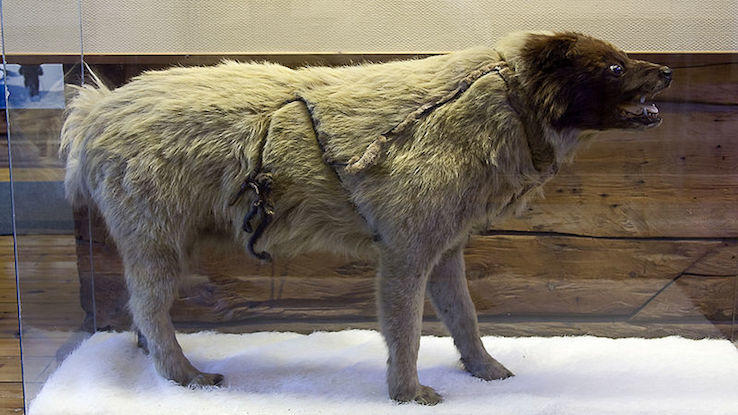
There’s a cinema inside that shows lectures on contemporary hygiene topics, such as smoking, drug abuse and AIDS risks. You can also enjoy displays of infectious diseases — including STDs — and get run-downs on bad health and hygiene habits, bizarre waxworks and, for some reason, Pavlov’s actual dog. The pooch is somewhat badly taxidermied, and photography isn’t allowed.
Admiration for Alcohol
Also in St. Petersburg, you’ll find Russia’s vodka museum. In honor of the national drink — in the 19th century the only legal vodka distiller in Russia was the government — this museum has it all covered.

You can learn all about vodka’s origins dating back centuries and track its evolution in culture over the years. You’ll also see ornate and bizarre bottles, stoppers and glasses. Of course, at the end of the 30-minute tour, you can enjoy some vodka tasting with borscht and caviar and even purchase a bottle from the over 250 different types of vodka available.
The Erotic Empress
Empress Catherine the Great II of Russia was credited by many as being the force behind the modernization of the Russian Empire. Unfortunately, her legacy is somewhat overshadowed by shocking reports of her sexual behavior.

Let’s address the elephant — or horse — in the room. There were rumors that Catherine died as a result of sexual relations with an equine, when in fact she died from a stroke. Some rumors held more truth though, such as the fact that she had many (often younger) lovers throughout her lifetime. She was also an avid collector of erotic furniture decorated with phallic and yonic carvings.
Baby Bonanza
Russians are granted state-funded parental leave, which of course isn’t unique to the country. What is one of a kind is the official holiday in the birthplace of Vladimir Lenin, Ulyanovsk, where everyone is allowed a day off for baby-making time.

The Day of Conception is held on September 12 and is taken so seriously that anyone who gives birth nine months later, on June 12, can be awarded prizes. These often include vehicles, video cameras, TVs, refrigerators and washing machines. The holiday was launched to overcome sexlessness among young Russians. Perhaps they should follow Catherine the Great’s lead?
Swimming With Sex Dolls
Arguably, more procreation might be possible if some Russians weren’t busying themselves with blow-up dolls. Each year in August, brave competitors plunge into the freezing waters of the Vuoksi River in Novosibirsk as part of the Bubble Baba Challenge. What makes this cold-water swimming event unique to Russia is that entrants must race 100 meters…using a blow-up doll as a flotation device.
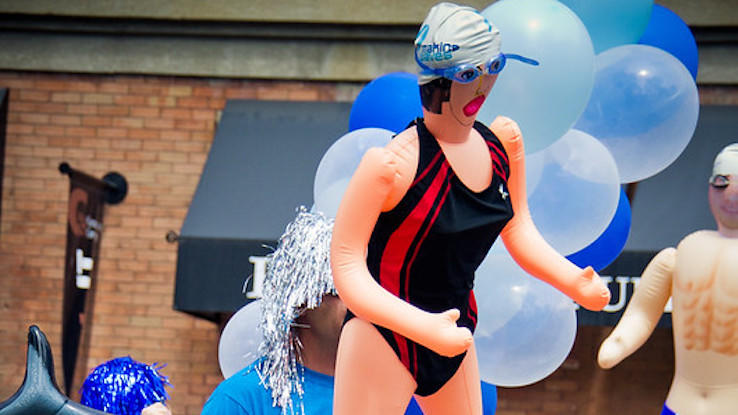
The first five swimmers across the finish line get prizes, and in 2011 there were an impressive 800 entrants. Any gender can participate, but they can’t visit the vodka museum first; breathalyzer tests before the race are compulsory.
The Cool Cat Cabaret
Now over to Moscow (or should that be Mosc-meow?). The Yuri Kuklachev Cat Theatre is the home and workplace of 200 cats of 38 different breeds that “perform” for visitors. The theater was founded by Kuklachev — a famous clown — around 30 years ago and features feline performers who dress up, jump through hoops, balance on balls, walk upright and perform other tricks.

Although there have been some claims of cruelty, Kuklachev reassures that, in typical feline form, it’s the cats themselves who choose which acts they perform. Apparently the training process involves simply playing with the cats until they reveal their special talents.
Rifles Not Rollercoasters
Who needs Disneyland when you can take the kids to Patriot Park? You won’t find log flumes, princesses or friendly mice here, but you can play with grenade launchers and have a go in one of the 32 shooting ranges (the longest being 1,400 meters).
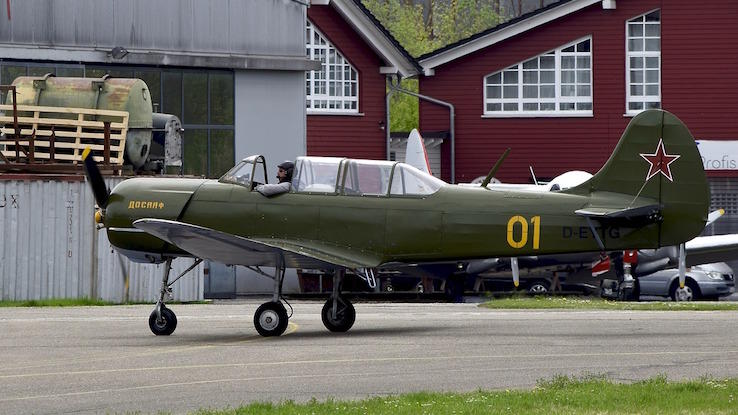
Patriot Park, based in Kubinka, covers 13,380 acres and was opened by Vladimir Putin in 2015. During the opening speech, he proudly declared that the military theme park would be “an important element in our system of military-patriotic work with young people.” Pretty useful stuff, considering Russian youths still have mandatory conscription at the age of 18.
Liaise With Lenin
When it comes to something you’d definitely only see in Russia, it’s Vladimir Lenin himself. After the Soviet leader died in 1924, a decision was made to embalm the revolutionary and put him on display in a mausoleum in Moscow.

The slightly waxy but asleep-looking Lenin is on display to the public four days a week. There do have to be some gaps in the exhibition though, as Lenin needs to be re-embalmed every two years. There are necessary touchups made to details such as his hair, nails and eyelashes — at a cost of around $200,000 per year.
The Embalmed Buddhist
If you want to make a tour out of visiting preserved Russian figures, then add Ivolginsky Buddhist Monastery near Ulsan-Ude to your list. The Buddhist monk Lama Dashi-Dorzho Itigilov died in 1927, and he was preserved in the lotus position. Before his death, he instructed followers to exhume his body in 30 years, and when they did, they found him still in the lotus position.

This led to some believers thinking he wasn’t dead after all, just in a deep meditative state. However, this somewhat goes against another theory that he exists as a ghost who walks the monastery grounds.
Beware the Babushka
This is one you can experience outside of Russia — if you ever have the pleasure of meeting a Russian grandma, or babushka, anywhere. The status gained when a Russian woman becomes a grandmother is sacred, and she’s a force to be revered and occasionally feared.

Babushkas are well respected and feature in Russian folklore and superstitions, although sometimes a little stereotypically. Just to be safe, though, always accept advice from a babushka, whether you asked for it or not. Never say no to her. If she cuts in front of you in a line, keep your mouth politely shut.
Lose Your Bottles
Russians have a tendency to follow omens and superstitions, with one uniquely Russian belief being that empty bottles left on tables can bring about financial hardship or other kinds of suffering or grief.

In particular this is applied to bottles that once had alcohol in them, and it’s believed to stem from Cossack soldiers who returned from France after the Napoleonic Wars. In an attempt to bring their restaurant bills down, the soldiers put empty bottles on the floor so the waiters wouldn’t count them in the final check — and the superstition built a more sinister momentum from there.
Spring Cleaning Saturdays
It’s common for Russians to dedicate a subbota, or Saturday, in the springtime to do unpaid or voluntary work. This can include tidying up the neighborhood or offering services to local hospitals, schools and other facilities.

The tradition stems from a post-revolution effort to raise enthusiasm among Soviet people and promote ideas of socialism. The annual tradition was held on Lenin’s birthday in the past, but nowadays, rather than being obligatory, it has friendlier connotations. Young people see it as fun and community-building, and although still called subbotnik, it doesn’t strictly have to be held on a Saturday or on Lenin’s birthday.
Animals in Outer Space
Russia is well known for its eagerness in the space race, so of course there’s a monument to the first Russian to go in a rocket: a dog named Laika. Although America pipped Russia to the post, first with fruit flies and then with a rhesus monkey called Albert, these journeys were only suborbital flights. Laika, a “quiet and charming” mongrel, actually went into orbit on the Soviet Sputnik 2 in November of 1957.

Sadly, this adventure doesn’t have a happy ending. Laika died during the expedition, likely due to overheating, but she lives on proudly as a statue in Moscow.
A Meaty Treat
Do you like Jell-O? Then imagine it without the fruitiness and with meat products such as boiled chicken feet and offal instead. The dish is called kholodets and is regarded as a delicacy reserved for big gatherings or festive events. Kholodets can take more than seven hours to prepare.

Many households have their own versions with different meat or poultry combinations. But in essence, the most gelatinous parts of the animal (feet, legs, ears, tails) are chopped and boiled. Then the combo is left to set. People often serve it with a dollop of horseradish and, frequently, vodka.
A Whale of a Time
Way up north in Russia is “whalebone alley.” You can kind of guess what this looks like by the name: There are whale skulls and other bones stuck in the ground, forming eerie structures.

Although the exact history is not known, it’s thought the area was used as a shrine by various villages along the coast, or perhaps intended as a site for rituals or sporting events. However, looking at the etymology of the area’s name, which to locals is siklyugak, meaning “meat pit,” it suggests whalebone alley was simply used as a butchering and storage area for whale meat.
The Terrifying Ticking
In St. Petersburg you’ll find the iconic Monument to the Heroic Defenders of Leningrad. Underneath the monument is a vault where people could seek shelter during wars. It now serves as a subterranean museum, displaying things like documents, awards, soldiers’ personal belongings, weapons and handwritten letters from young boys pleading to join the army.

So what makes this museum unique to Russia? Well if the displays weren’t eerie enough, the only sounds playing in the museum are the endless ticking of a metronome interspersed with old emergency announcements transmitted on the radio. These were the only noises transmitted during the siege.
Su-purr-b Pest Control
You’ve not heard the last about cats on this list. However, rather than performing tricks in funny outfits, there are around 70 felines with a more serious function in St. Petersburg’s grand Hermitage Museum.

The Hermitage cats roam the grounds of the museum — which has around 14 miles of marbled corridors — to guard its many treasures against rodents. There are special kitchens for preparing the cats’ food and even a small vet clinic. The furry workforce was introduced in the 18th century when the daughter of Peter the Great, Empress Elizabeth, spotted how well cats controlled the buildings’ mice populations.
The Conundrum of the Chamber
This is another Russian relic that only exists in hushed whispers — because no one knows where it actually is. There was a lot of upheaval during WWII, with plenty of wreckage in its wake. One of the most puzzling mysteries is that of the Amber Room, which once stood proudly in the Catherine Palace of Tsarskoye Selo near St. Petersburg.

The chamber, decorated in amber panels with gold leaf and mirrors, was trashed by the Nazis but brought to Königsberg (now Kaliningrad) for reconstruction. However, it was somehow mislaid at some point and has not been traced since.
Time After Time
Russia has had more time zones — once a total of 11 — than any other country. However, since 2011 there have only been nine in use.

In addition, Russia has changed its mind a few times about daylight saving time on multiple occasions. It was first introduced in July of 1917 by a decree of the Russian Provisional Government, but a Soviet Government decree abandoned it six months later. The USSR reintroduced it in 1981 but decided to switch to European daylight saving time in 1984. This ended in 2011, when Russia stopped observing daylight saving time.
Swing High, Sweet Chariot
In Russia, you can have a go on the highest swing in the world, the SochiSwing, situated in the Sochi SkyPark. Home to the 207-meter-high SkyBridge, the swing flings riders 458 meters across a ravine. As if that wasn’t enough, you could also try out the zip wire ride, which reaches speeds of around 90 miles an hour.

Alternatively, visitors can take a scary stroll along the bridge above Krasnaya Polyana valley. This is one of the longest suspended pedestrian bridges in the world. It sits among lush mountains and gorgeous scenery of the Black Sea coast.
Part-time Politicians
As if running a country wasn’t hard enough, a couple of Russia’s most renowned rulers have been keen to show off the rest of their skill sets. First up? Former Soviet Union leader Mikhail Gorbachev. In 2009, a CD of Gorbachev singing was sold at auction for around $165,000. The album was called Songs for Raisa and featured a number of tunes that his wife, who died in 1999, loved.

If you’re more into sports than music, perhaps you should seek out Putin’s DVD. Let’s Learn Judo with Vladimir Putin was released in 2008, and it teaches viewers about Vlad’s favorite combat moves.
The Secret Security Shuttle
Although this isn’t something that ordinary people can see for themselves, it is a secret exclusive to Russia. Legend has it that there’s another metro system, Metro-2, that connects a collection of military bunkers running parallel to the main Moscow Metro. It’s allegedly run by the Ministry of Defence of the Russian Federation and was built between 50 and 200 meters deep during Joseph Stalin’s era.

Metro-2 — codenamed D-6 (or Д-6) — has been said to have four lines (shown as dashes in the picture), connecting the Kremlin with the Federal Security Service headquarters, the government airport at Vnukovo-2 and even an underground town.
The Island of Attractions
Vasilyevsky Island in St. Petersburg is a must-visit destination in Russia thanks to its sheer variety of curious attractions, including everything from a pair of 15th-century Egyptian sphinxes to the skeleton and heart of Peter the Great’s giant personal servant.

The easternmost tip of the island, known as the Spit, is home to numerous museums, palaces, cathedrals and universities, many of which date from the 18th century. Recently installed is a floating, illuminated musical fountain. In the center of the island, you can visit the Museum of Electrical Transport, which is situated in a charming old tram depot.
Gallivanting at a Gulag
Believe it or not, there are discussions underway about converting former gulags — Russia’s hard labor camps — into tourist attractions. The Sakha Republic in Eastern Siberia is considering the controversial plan as a way to attract more visitors. While Sakha, which is almost the same size as India, is the biggest subnational governing body in the world, it has fewer than a million residents.

So, the tourism department hopes that a makeover will boost the population and visitor count. Tourism chief Yekaterina Kormilitsyna was quoted as saying, “This project will preserve the historical heritage not only of the region but of the entire country.”
Feel the Chill
Also in the Sakha Republic, you can find the coldest inhabited place in the world. Oymyakon, literally meaning “frozen lake,” has the lowest ever recorded temperature of −67.7 degrees celsius, which was logged in February of 1933.
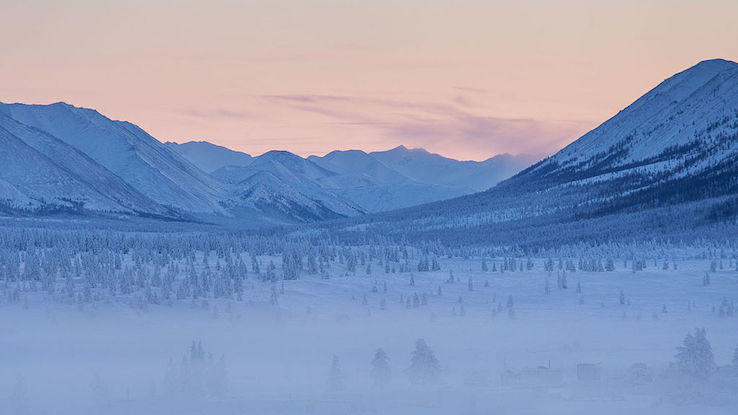
It’s cold for many months of the year, and snow is a regular occurrence. However, people do still live here, including young children, who are still allowed to attend school as long as it doesn’t get colder than around -50°C. Unsurprisingly, the population is shrinking. At its peak, there were around 2,500 inhabitants, but in 2018 the number was down to fewer than 900 people.
Last Chance for a Language
If you’re a fan of all things linguistic, you might want to rush to Russia’s Kola Peninsula. There, you can hear the last speakers of the ancient Ter Sámi language. Once, Sámi languages were spoken across parts of northern Russia, Norway, Sweden and Finland. Because the Ter Sámi language has no standardized written form, only a few examples of audio recordings and rudimentary dictionaries exist for study purposes.
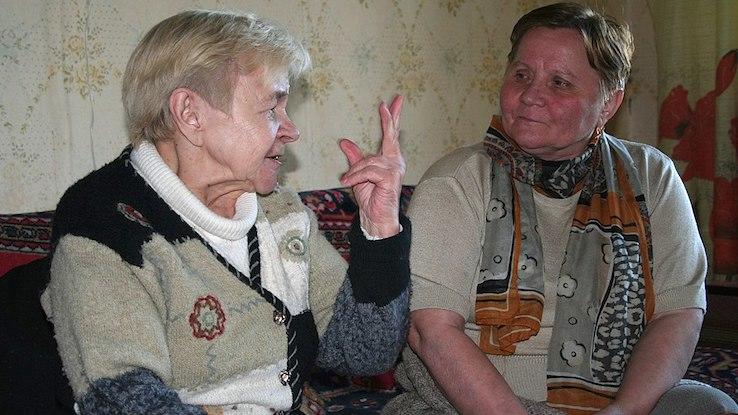
The decline of the language was due to it being prohibited in Soviet times, and sadly, inhabitants were forced to leave the largest Ter Sámi village, Yokanga, in the 1930s.
Pollution Aplenty
Thankfully now filled in, Lake Karachay was a small lake in the southern Ural Mountains that the Soviets used in the 1950s as a dumping ground for radioactive waste. It was said that standing for just one hour beside the lake could be deadly, and in fact according to the Worldwatch Institute, an environmental research organization, Karachay was the most polluted open-air space in the world from a radiological perspective.

After a regional drought in 1968, the wind blew five millicuries (the unit of radiation) of dust away from the dried-out lake, irradiating half a million people.
An Infamous Phallus on Display
If you visit the erotica exhibition in St. Petersburg, be sure to take a peek at Rasputin’s penis. Yes, you read that correctly. Although the display has its doubters, museum founder Igor Knyazkin is sure that the 30-centimeter-long pickled penis does belong to the infamous playboy priest.

The problem is, in the many years since Rasputin’s murder in 1916, this isn’t the first time people have come forward to say they have his severed member in their posession. Nevertheless, the erotica exhibition, which is open 24 hours a day, is still worth a visit for its other oddities (including a display dedicated to Catherine the Great, of course).
Double the Fun
After that interesting, shocking and sometimes baffling tour of Russia’s weird and wonderful, let’s finish on a positive note. Hoping to place Russia on the culinary map, identical twin chefs Ivan and Sergey Berezutskiy run a restaurant called Twins Garden. Their first venture attracted thousands to its tasty food and unique experience, owing to the fact that the whole restaurant was staffed by — you guessed it — twins.

The restaurant is stocked by a farm outside Moscow, which produces 70% of the ingredients used in the kitchen. Leftovers are sent back to feed the farm’s animals, making the restaurant a near-zero-waste operation.






